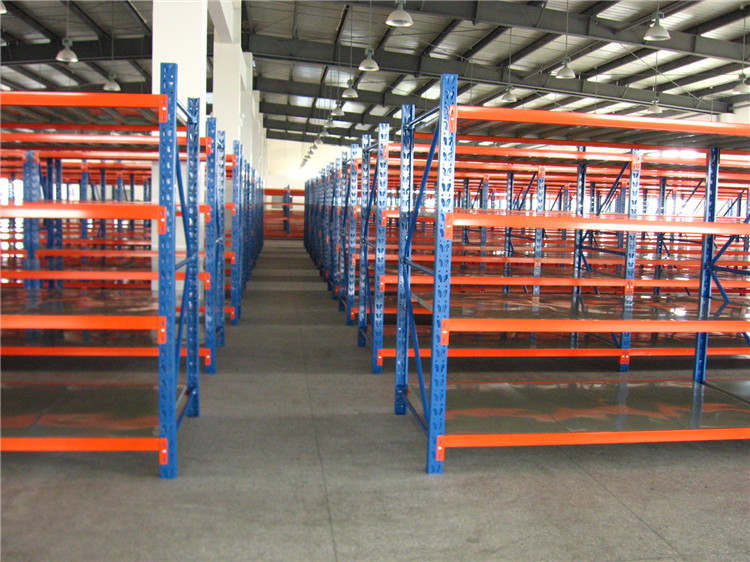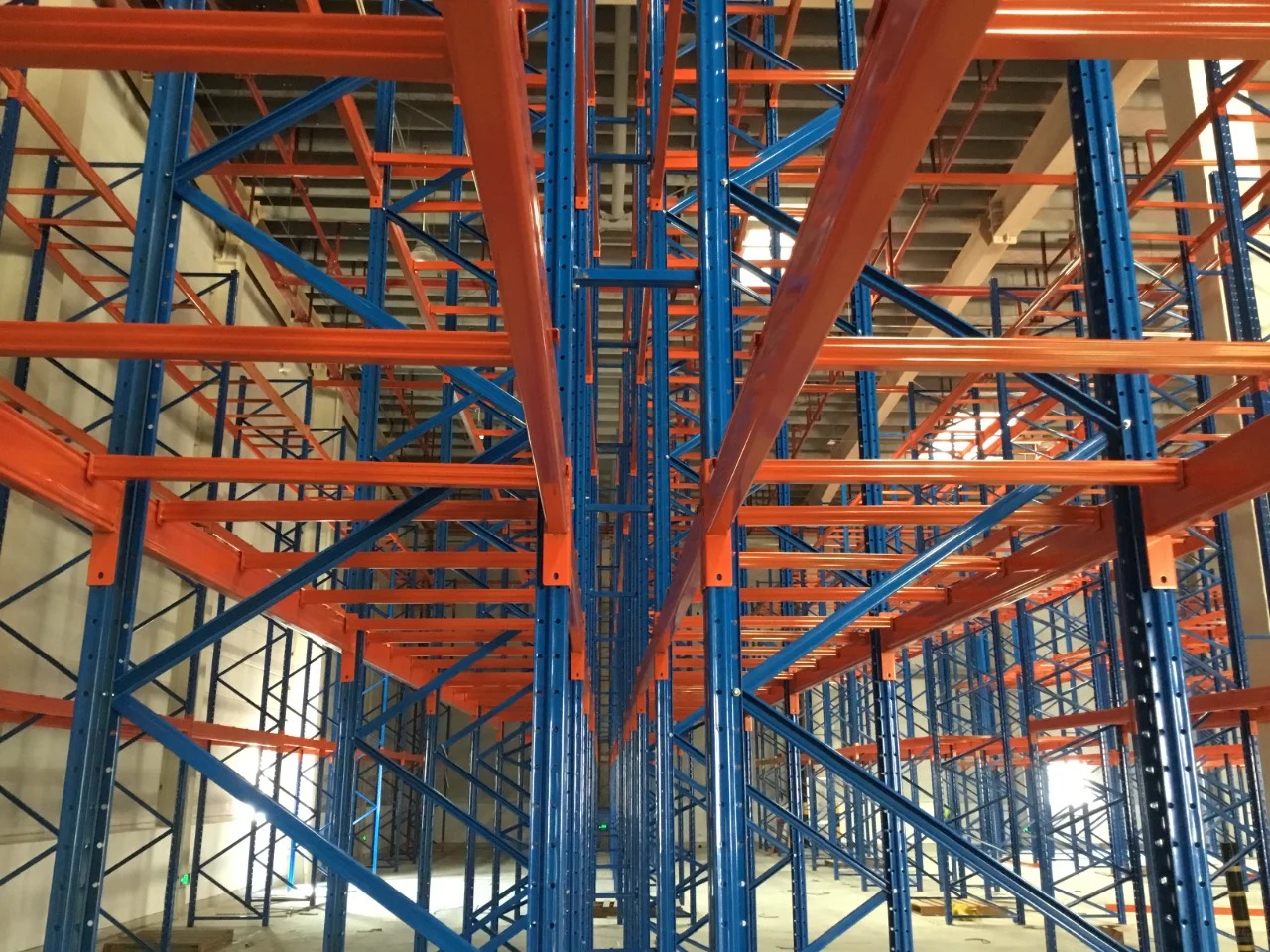In the relentless pursuit of warehouse optimization, maximizing available cubic space is paramount. For operations dealing with large volumes of homogeneous or slow-to-moderate moving SKUs, traditional selective racking often falls short in density. Enter Drive Through Racking, a high-density storage solution designed to transform aisle space into valuable storage locations. This comprehensive guide delves deep into the world of Drive Through Racking, exploring its fundamental principles, structural components, operational workflows, significant advantages, and crucial implementation considerations. If you're battling space constraints and seeking a balance between density and reasonable accessibility, understanding Drive Through Racking is essential.

What is Drive Through Racking? The Core Concept
Drive Through Racking, often referred to as drive-in pallet racking, is a high-density storage system where forklifts literally drive into the rack structure itself to place and retrieve pallets. Unlike selective racking with dedicated aisles for each pallet position, Drive Through Racking utilizes deep storage lanes accessible from one or both ends. Pallets are stored on rails or rails with rollers, resting on load beams that span the width of the lane. The defining characteristic is that the forklift operates within the storage lane, eliminating the need for dedicated access aisles between each storage row. This design dramatically reduces the aisle footprint required, converting what would be wasted aisle space into productive storage locations. The core principle of Drive Through Racking is Last-In, First-Out (LIFO) inventory management when accessed from one end, or First-In, First-Out (FIFO) when configured for access from both ends.
Key Components and Structural Design of Drive Through Racking Systems
Understanding the robust structure is vital to appreciating the capabilities of Drive Through Racking:
1.Upright Frames: These are the vertical columns that form the backbone of the system. They are typically heavier-duty than selective racking frames to withstand the dynamic forces of forklifts operating within the lanes and the substantial loads carried deep within the structure. Bracing provides lateral stability.
2.Guide Rails: Running the length of each storage lane, these rails (often angle iron or structural channels) mounted to the uprights provide critical guidance for the forklift wheels, ensuring safe and accurate travel deep into the racking. They prevent the forklift from straying and damaging the structure or stored goods.
3.Load Beams: These horizontal members connect the upright frames across the width of the lane. Pallets rest directly on these beams. They are designed for high point loads and are often reinforced. Their elevation defines the storage levels.
4.Pallet Supports/Rollers: While pallets can rest directly on the beams, many Drive Through Racking systems incorporate pallet support rails or rollers within the lane. Rollers can facilitate easier movement of pallets, especially in gravity-flow variants or for FIFO applications.
5.Entry Guides & Bumpers: Reinforced entry points guide the forklift smoothly into the lane. Heavy-duty bumpers protect the front uprights from impact damage during entry and exit.
6.End Frames & Bracing: The ends of the lanes require robust framing and diagonal bracing to ensure the entire structure remains stable, especially for taller systems.
The design prioritizes strength and safety, considering the constant interaction between heavy machinery and the storage structure.
How Drive Through Racking Operates: The Workflow
The operational workflow of a Drive Through Racking system is distinct:
1.Lane Loading (One-End Access - LIFO):The forklift approaches the designated lane entrance.Carefully aligning with the guide rails, the forklift drives directly into the lane.The operator places the pallet onto the appropriate level's load beams, typically starting at the back of the lane and working forward.Subsequent pallets of the same SKU are placed directly in front of the previous one, filling the lane forward.To retrieve a pallet, the forklift enters the lane and removes the front-most pallet (the last one put in). Accessing pallets behind requires moving the front pallets first (LIFO).
2.Lane Loading (Two-End Access - FIFO):Pallets are loaded into one end of the lane (e.g., End A).The forklift drives through the entire lane to place pallets consecutively towards the opposite end (End B).Retrieval occurs from the opposite end (End B), taking the first pallet that was loaded at End A. This achieves FIFO inventory flow.Requires clear, safe access routes at both ends of the lane.
3.Forklift Requirements: Operating within the confined space of a Drive Through Racking lane demands skilled operators and appropriate equipment. Reach trucks are commonly used, but standard counterbalance forklifts can be used if aisle width and mast design permit. Guidance systems (like rail guides or wire guidance) significantly enhance safety and precision within the lanes.

Major Advantages of Implementing Drive Through Racking
Choosing Drive Through Racking delivers compelling benefits, primarily centered on space utilization:
1.Exceptional Storage Density: This is the primary driver. By eliminating numerous aisles, Drive Through Racking can increase storage capacity by 60-75% or more compared to selective racking within the same warehouse footprint. It utilizes up to 85% or more of the available floor space.
2.Optimized Cube Utilization: The system efficiently uses vertical space, often reaching warehouse clear heights similar to other racking types. Combined with deep lane storage, it maximizes pallet positions per square foot.
3.Cost-Effective Solution (Per Pallet Position): Due to the high density, the cost per stored pallet position in a Drive Through Racking system is often significantly lower than selective racking. Fewer overall upright frames and beams are required per pallet spot.
4.Ideal for Homogeneous, Slow/Medium-Moving SKUs: It excels when storing large quantities of the same product (e.g., beverages, packaged goods, raw materials) with predictable, manageable turnover rates. LIFO is suitable for non-perishable goods or where batch sequencing isn't critical; FIFO configurations handle perishables effectively.
5.Structural Strength and Durability: Designed to withstand the rigors of forklift traffic within the lanes, high-quality Drive Through Racking systems offer long-term durability and reliability.
6.Reduced Aisle Lighting/Cooling Costs: Fewer aisles translate directly to lower energy costs for lighting and potentially for climate control in those areas.
Critical Considerations and Potential Challenges
While powerful, Drive Through Racking isn't a universal solution. Careful consideration of these factors is crucial:
1.Inventory Management Method (LIFO/FIFO Limitation): This is a fundamental constraint. Pure Drive Through Racking forces LIFO with one access point, which is unsuitable for perishables or strict FIFO requirements. FIFO requires two access points and careful traffic management. It doesn't offer direct access to every pallet like selective racking.
2.Reduced Accessibility & Throughput: Accessing a specific pallet deep within a lane can be time-consuming, as it may require moving other pallets first (especially in LIFO). This inherently limits the maximum possible throughput compared to selective racking.
3.Forklift Operator Skill and Safety: Operating within the confined lanes requires highly skilled, trained, and attentive operators. The risk of product damage (from mishandling) and rack damage (from impacts) is higher than in wide-aisle systems. Strict safety protocols are non-negotiable.
4.Product Compatibility: Works best for uniform, stable, durable palletized loads of the same size and weight. Fragile goods or inconsistent pallet sizes increase risk. Weight distribution across the beams is critical.
5.Warehouse Floor Requirements: The floor must be exceptionally flat and level to ensure safe forklift operation within the lanes and prevent pallet instability. Significant unevenness can cause safety hazards and operational inefficiencies.
6.Potential for Reduced Productivity: While density increases, the time taken per put-away or retrieval can be longer than in selective racking due to the driving-in/out process and potential lane reshuffling (LIFO). This needs careful analysis against density gains.
7.Implementation Cost: While cost per pallet position is low, the upfront cost for the robust structure, guide rails, and potentially specialized forklifts can be significant. Requires a thorough ROI analysis.
Implementing Drive Through Racking Successfully: Best Practices
Maximizing the benefits and minimizing risks requires a strategic approach:
1.Thorough SKU Analysis: Rigorously analyze inventory profiles. Drive Through Racking shines for high-volume, homogeneous, slow/medium-turnover SKUs. Avoid using it for fast-movers or highly variable SKUs.
2.Clear Definition of LIFO vs. FIFO Needs: Determine the absolute inventory flow requirements for the products destined for this system. Choose single-end (LIFO) or double-end (FIFO) configuration accordingly. Don't force FIFO onto a LIFO system.
3.Professional Design and Engineering: Engage experienced racking system designers and engineers. Critical factors include:Precise lane depth (number of pallets deep) and height.Beam levels and load capacities.Upright frame specifications and anchoring.Guide rail design and mounting.Comprehensive seismic and safety calculations.
4.High-Quality Materials and Installation: Invest in robust, certified components. Ensure installation is performed by qualified professionals adhering strictly to design specifications and safety standards. Proper anchoring is critical.
5.Forklift Selection and Operator Training:Choose forklifts with the appropriate mast height, width, and load capacity for the racking dimensions.Prioritize trucks with excellent visibility and maneuverability.Implement mandatory, rigorous training programs focused specifically on safe operation within Drive Through Racking lanes, including entry/exit procedures, speed control, load handling, and emergency protocols. Regular refresher training is essential.
6.Stringent Safety Measures:Install clear lane identification and directional signage.Implement strict speed limits within racking areas.Use high-visibility markings and potentially proximity sensors.Enforce a "one forklift per lane" rule absolutely.Conduct regular rack inspections for damage (especially guide rails and front uprights).
7.Optimized Warehouse Layout: Plan the overall warehouse flow carefully. Position Drive Through Racking zones logically in relation to receiving, staging, and shipping areas to minimize unnecessary travel. Ensure adequate space for forklifts to maneuver safely outside the lanes.
Is Drive Through Racking Right For Your Operation?
Drive Through Racking remains a highly effective weapon in the warehouse optimization arsenal, offering unparalleled storage density for the right inventory profile. Its ability to transform aisle space into valuable storage locations provides a tangible solution to space constraints and can significantly lower the cost per pallet position. However, its success hinges entirely on a clear understanding of its strengths – density for homogeneous, slower-moving goods – and its inherent limitations – primarily the LIFO/FIFO constraint and reduced accessibility.
Carefully weigh the advantages of maximized space utilization against the operational realities of slower throughput and higher demands on operator skill and safety. Conduct a detailed analysis of your specific SKU velocity, inventory management requirements, available budget, operator capabilities, and warehouse infrastructure. When applied judiciously to suitable product lines, a well-designed, professionally installed, and rigorously managed Drive Through Racking system can be a cornerstone of an efficient, high-density storage strategy, delivering substantial long-term value and overcoming critical space challenges.







